Home Safety Checklist For Lexington
Staying safe in your residence should be your number one priority. But are you forgetting a few big safety items? Look over this home safety checklist for Lexington and find out where your living space requires some work.
This guide begins with some whole-home safety ideas, and then we break it down room-by-room. Then, call (859) 279-1710 or complete the form below to speak to a security professional.
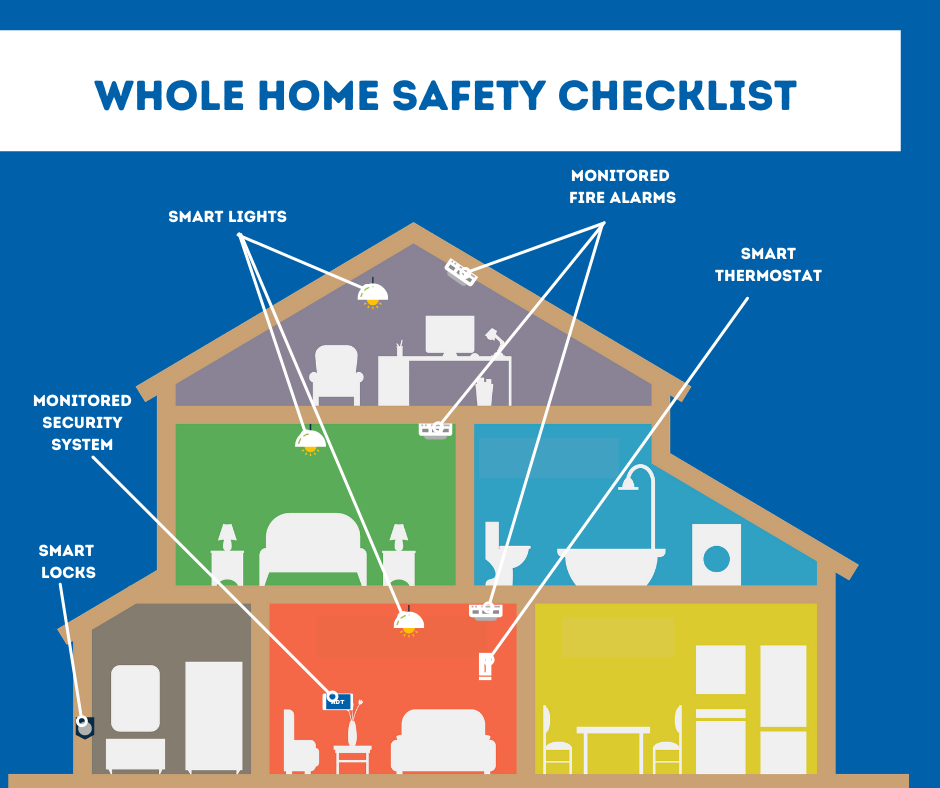
Whole Home Safety Checklist for Lexington
While you should employ a individual room method for home safety in Lexington, there are some methods that work for all of your rooms. These components can talk to each other through a smart hub, and often can react to other components. You can also manage each of your home safety devices through a smartphone app, like ADT Control:
-
Monitored Home Security System: Each one of your entryways should use a sensor that notifies you and your family to a break-in. After your alarm triggers, your monitoring expert responds to the alert and sends a first responder.
-
Smart Lighting For Every Major Room: Of course, you can schedule your smart bulbs to become more eco-conscience. But they can also help you remain safe throughout an emergency. Have your lights flip on when a security alarm trips to frighten off robbers or brighten your way to a safe area.
-
Smart Thermostat: Likewise, a smart thermostat in Lexington should save you between 10%-15% in utility costs. Also, it can start an exhaust fan if you have a fire.
-
Monitored Smoke Detectors: It’s code that you will have a fire detector on every level of your house. You can improve your fire readiness by installing a monitored fire alarm that looks for unusual smoke and heat, and alerts your 24/7 monitoring team when it senses a fire.
-
Smart Locks: Every entryway that utilizes a keyed lock can use a smart door lock. Now you may set numbered codes to friends and family and get alerts to your smartphone when your locks are unlocked. Your locks can even automatically unlock, allowing you to quickly flee the house when you have an emergency.
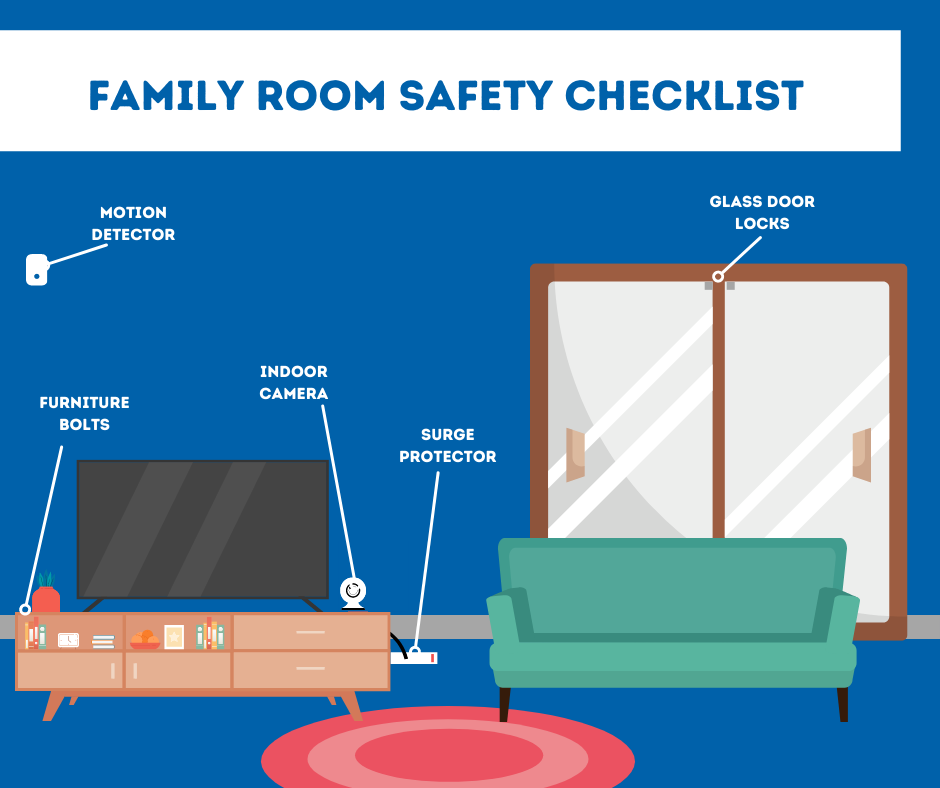
Living Room/Family Room Safety Checklist For Lexington
You’ll spend a lot of time in the living room, so it can be the best place to improve your home safety. Popular items, like a big screen or stereo system, probably reside in your family room, making it an alluring area for burglars. Begin with placing a motion detector or indoor security camera by the doorway, then take a look at the following safety protocols:
-
Motion Sensors: By putting in motion detectors, you’ll hear a high-decibel noise whenever they sense suspicious movement in your living room. The best devices are motion detectors that aren’t set off by a dog or cat or you’ll see your sirens go off every time your cat roams by for a midnight stroll.
-
Indoor Camera: An indoor security camera gives you a constant watch on your living room. Get real-time streams of everything so you can see what’s downstairs from the mobile app. Or talk with your family in the living room with the two-way talk feature.
-
Surge Protector/Cord Maintenance: Safeguard expensive electronics and stop overloading your electric system with a surge protector. For added energy-efficiency, use a smart plug with anti-surge functionality included.
-
Entertainment Center Secured To The Wall: If you have any small children, you’ll want to secure your heavy furniture and entertainment center to the wall. This is extra important if your living room has carpet that might make objects extra unbalanced.
-
Special Locks For Glass Doors: If your living room has a sliding door that leads to a patio, deck, or porch, you probably know that the latch is pretty thin. Put in a custom lock, like a cross bar or locks that bolt to the top and bottom of the frame.
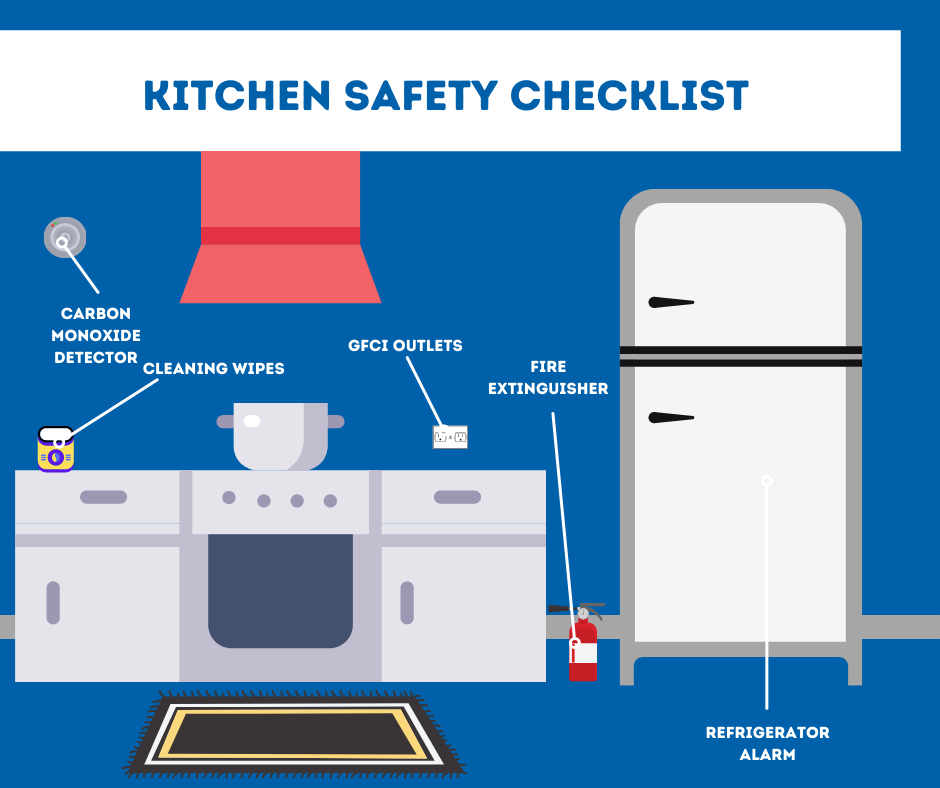
Kitchen Safety Checklist For Lexington
Your kitchen has plenty of items that should provide safety and security to your house. Most of these items are also easy to add and should be purchased from the Target or Walmart:
-
Fire Extinguisher: A fire can happen from an unwatched frying pan or a faulty burner. Always have a fire extinguisher in close reach for any cooking emergencies.
-
Circuit Interrupter Box On Each Outlet: A GFCI outlet should be standard anywhere there’s nearby water to ward off electrocution. That includes the outlets close to your sink and kitchen counter. Since 1987, it’s been standard to have one circuit interrupter outlet per dedicated circuit. But all your outlets will go dead if any outlet detects a surge, so try to have an unchained GFCI for every outlet.
-
Monitored Carbon Monoxide Detector: A CO detector is advised for kitchens that use natural gas for the oven and range. If your gas burners malfunction, the CO detector will play a loud noise and ping your monitoring professional.
-
Cleaning Wipes Or Spray: The most overlooked safety issue in the kitchen is the viruses, bacteria, and cross-contamination that comes with blood from meat and dairy. Always store antiviral wipes or spray to sanitize your surfaces when cooking.
-
Refrigerator Alarm: The food items in the refrigerator should remain at a cold temperature to stay ready to consume. If you accidently leave the freezer or refrigerator door open, then an alarm beep will remind you to check the seal. Some refrigerators come with an alarm, older models don’t, and you’ll have to get an external alarm from the hardware store.

Bathroom Safety Checklist For Lexington
Just because there’s not a lot of space in your bathroom doesn’t mean that there aren’t safety issues. From flood prevention to anti-surge outlets, here are five safety ideas for your bathroom:
-
Flood Sensors: A leaking sink or tub can create extensive destruction. Find out early about pooling water with a flood detector and save yourself from redoing the entire bathroom.
-
Textured Bathroom Mats: A fall in the bathroom can be devastating, causing pulled muscles, sore joints, or trips to the hospital. Or prevent these issues with a textured bathroom mat for your wet feet.
-
Non-slip Bathtub Strips: Likewise, a tub basin can be a slick place to move in. It’s a good idea that every bathtub has some non-slip stickers so your feet and toes have a bumpy patch to gain traction.
-
Medicine Door Latch: If you have curious toddlers or a family member with memory complications, you should take extra attention regarding prescribed medicine. Secure your pills and syrups by using a medicine cabinet with a latch that locks.
-
GFCI Circuits: While installing better outlets in the kitchen, you will have to also use a grounded circuit interrupter outlet on every bathroom receptacle. This will cut the electric current if they ever get wet or you have a sudden jolt from a hair dryer or curling iron.
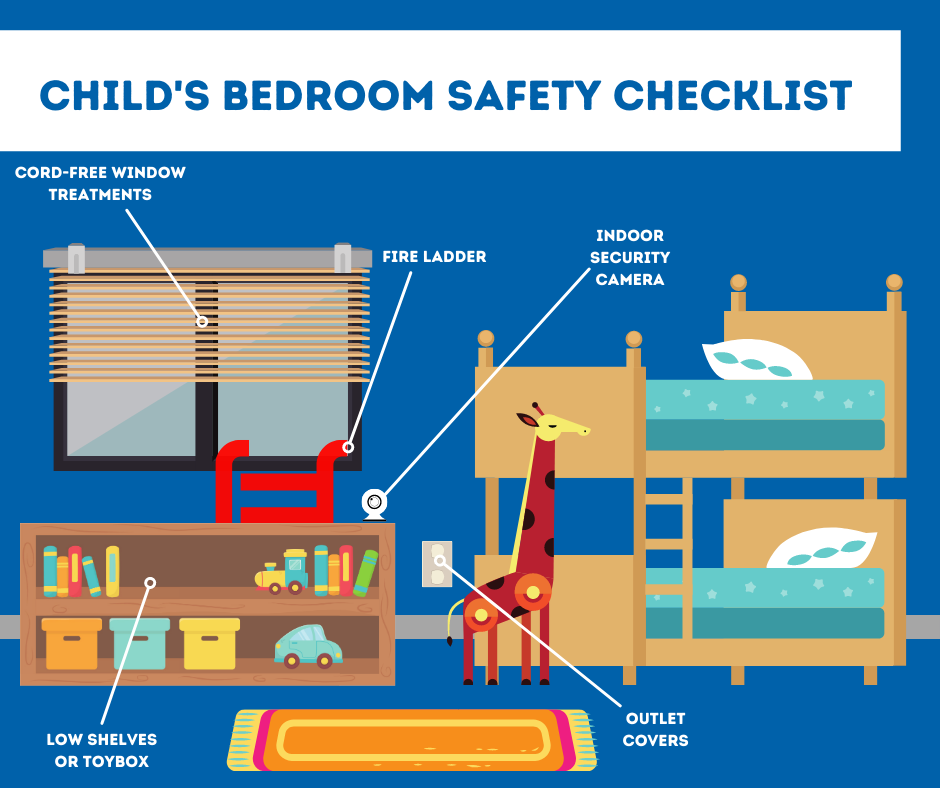
Child’s Bedroom Safety Checklist For Lexington
Your child’s bedroom should balance safety with manageability. If their window coverings or other items are safe but tricky to manage, then your kids may perform dangerous activities -- like shimmying up a dresser -- to use them. Here are some easy, yet safe, ideas:
-
No Cord Window Treatments: Safety agencies have long called window treatment cords a secret danger for children and animals. Install motorized treatments that you can easily manage with a remote. Or better yet, pair your motorized coverings to your ADT smart hub so they open on a schedule at dawn, and close at bedtime for added darkness.
-
Tableside Security Camera: An indoor security camera sitting on your toddler’s desk can behave as an HD baby monitor that you can watch with your phone. And if they need something, they can hit the two-way talk feature included on the camera.
-
Outlet Covers: While each outlet should have outlet safety caps on them to protect your little children, this is doubly needed in their bedroom. It’s the one room in your house where your toddler will most likely hang out by themselves without parental supervision.
-
Window Escape Ladder: If you use bedrooms on above the first story, then you need to have a window fire ladder. These can let your children leave the house in case the stairs or downstairs are engulfed in smoke and fire. Remember to rehearse how to unfurl the ladder a few times a year.
-
Toy Box Or Low Shelves: It’s weird to view a toy box as a safety device, but you’ll understand if you’ve ever tramped on an action figure in your stocking feet. A clutter-free floor let your child have a quick escape when there’s a fire or break-in.
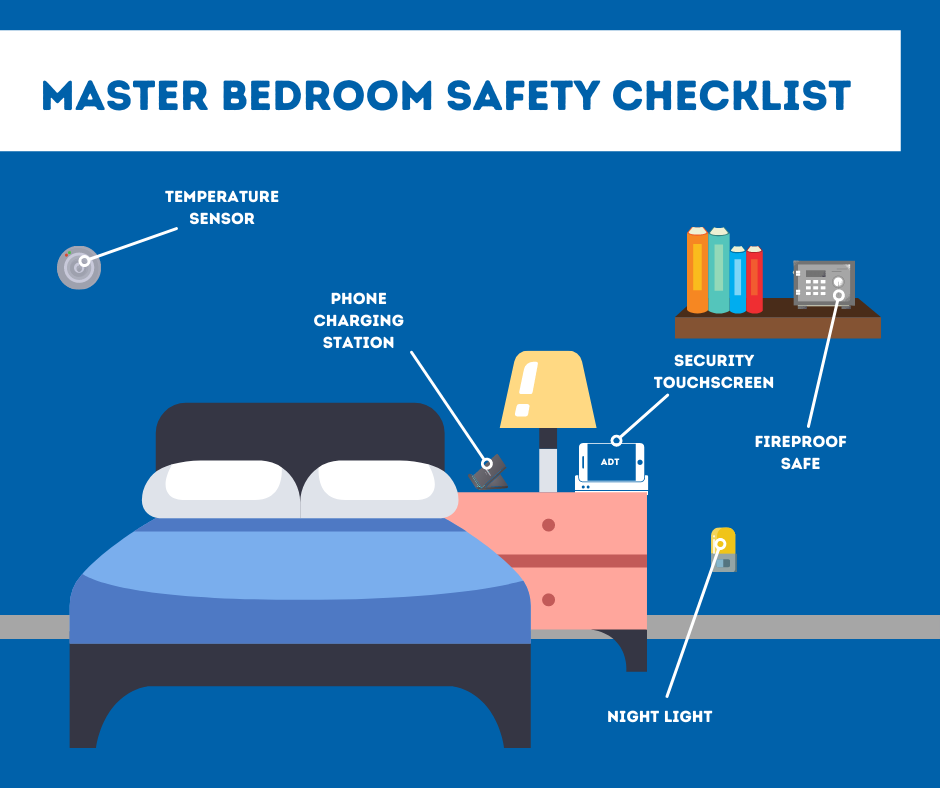
Master Bedroom Safety Checklist For Lexington
Your main bedroom should be a refuge, so let your safety devices make life easier when there's an emergency. After all, being startled awake by a high-decibel alarm can be confusing.
-
Security System Touchscreen: Having a smart hub on your nightstand lets you see what’s happening without jumping out of bed. You could always log into your ADT smartphone app but, the large touchscreen can be easier to manage to use when you’re bleary-eyed and disoriented.
-
Phone Charging Area: We rely on our smartphones for so much now alarm clocks, news readers, games, and maybe even phones. However, a depleted phone in the middle of the night cuts us off from communications if something goes wrong. To make sure your phone always works, a charging cord or station is should be used nightly.
-
Nightlight/Smart Lights: A small light can be a beacon when you’re bolted awake from a fire alarm or unexpected noises. If you can’t fall asleep with a nightlight, install a smart bulb in your bedroom. Then you can get light on-demand with a mobile device or voice direction.
-
Fireproof Lockbox: Store your essential papers like birth certificates, stock certificates, or a spare checkbook in a fireproof safe. Your safe can be a large one that camps out out of the way or a smaller handheld lockbox that you can grab as you escape during a fire or other emergency.
-
Temperature Sensor: The drawback with most bedrooms is that they can run too hot or be cold since they are far from the thermostat. A temperature sensor can talk to your smart thermostat so you will have a comfortable, restful sleep at the perfect climate.
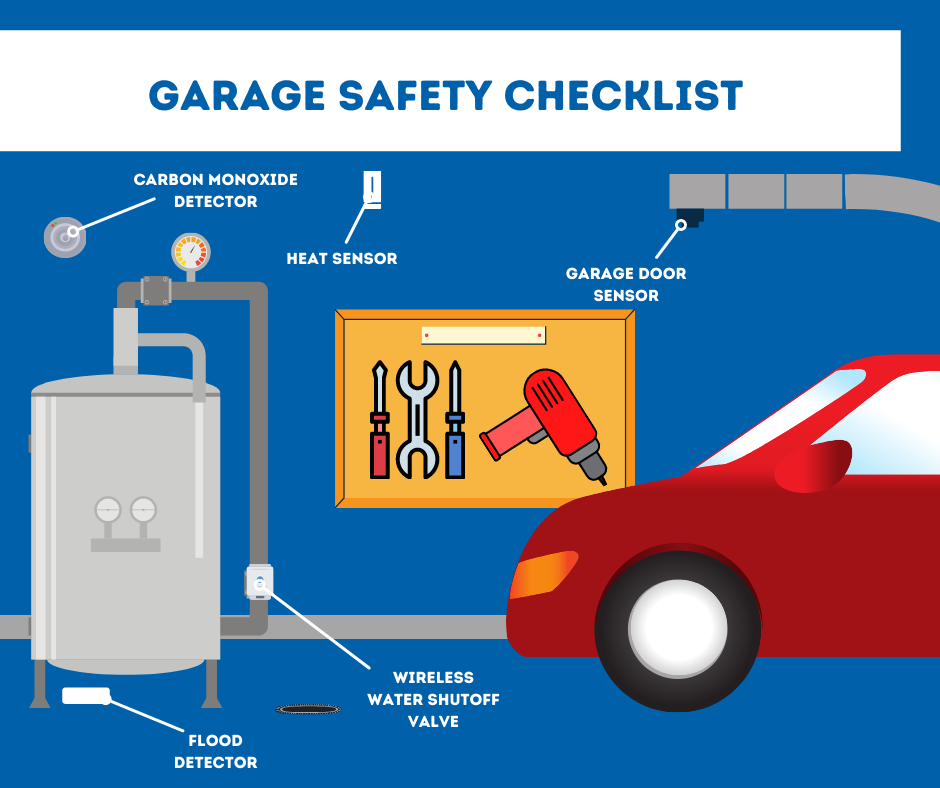
Garage/Basement Safety Checklist For Lexington
Most safety problems in the basement or garage are with your pipes or furnace. Seeing hazards at the source can stave away more devastating disasters later on. So, as you take a look around your basement or garage, pay attention to these crucial items:
-
Flood Sensor Or Sump Pump Alarm: Installing a flood sensor by your water heater or sump pump can save you from finding a pond when you go into your basement or garage. The last you need is to waste the weekend getting rid of standing water and going through all those soggy boxes.
-
Carbon Monoxide Detector: It’s nice to have a carbon monoxide detector in an area where a natural gas leak can occur. If you employ gas heat, try to put a detector in the same area as your HVAC unit.
-
WiFi Water Shutoff Valve: If your water alarm finds a hot water heater leak or a burst pipe, then you will have to cut off the main water line at once. With a WiFi shutoff valve, you can stop water flow from any mobile device. That’s perfect when you’re out of town and get an emergency leak text on your smartphone.
-
Garage Door Sensor: Leaving the garage door up brings about all sorts of headaches. You can lose a bunch of heat or air through that large opening, and rodents or thieves can just walk in. A sensor will text you about a forgotten garage door and lets you close it remotely.
-
Temperature Sensor: A heat sensor in your garage or basement is essential if you wonder about freezing pipes. The temperature in these rooms can be surprisingly different than the rest of the house, so you will need to have a closer eye on them through your mobile app.
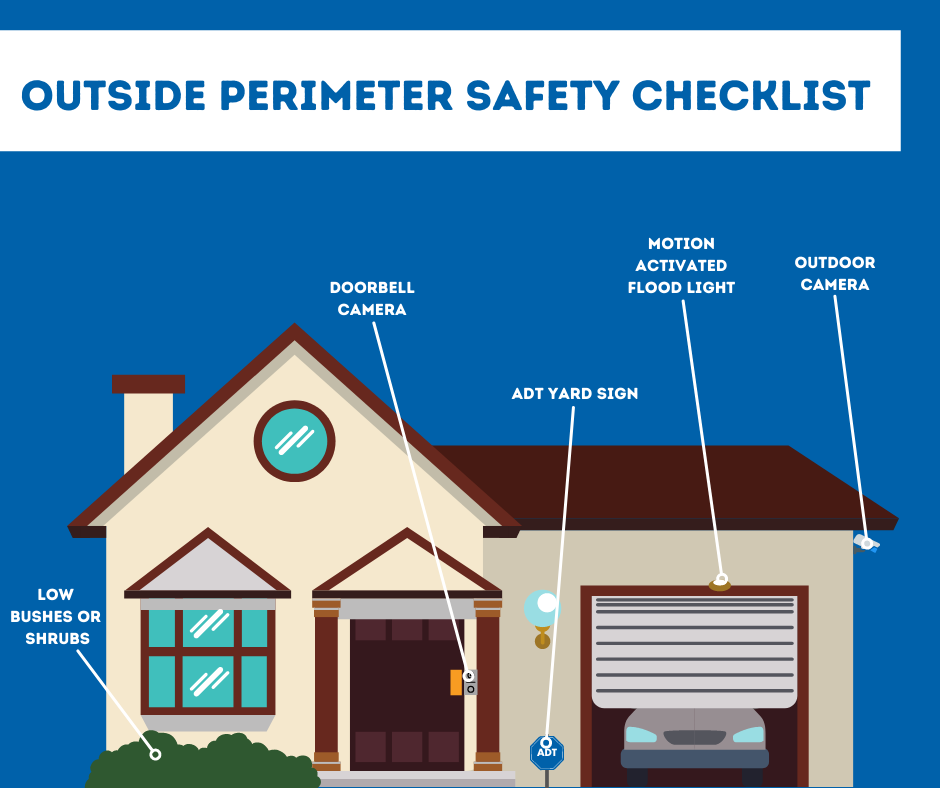
Home Perimeter Safety Checklist for Lexington
Your front yard, driveway, and front porch are just as important to make safe as the inside of your house. Try the items on this checklist to make your outside safe:
-
Doorbell Security Camera: See who’s knocking on the front door before you answer it and chat with guests. See packages and review video clips if they are taken.
-
Outdoor Security Camera: You can install outdoor cameras to guard against late night lurkers in your back yard. These devices are nice in places where you may not have a window installed -- like around a cellar or by the garage.
-
Low Shrubs: High bushes can give you some solitude, but they also obscure your line of sight of the outside. Don’t give potential thieves a place to hide. Plus, high bushes or trees too close to your structure can clog gutters and bring in pests.
-
ADT Signage: One of the most popular discouragements for home intrusion is alerting aspiring intruders that you have a state-of-the-art home security system. An ADT sign by the front door and a window decal will show ne'er-do-wells that they should move on to an easier house.
-
Motion Controlled Outside Light Fixtures: Light is the biggest enemy to people who skulk in the dark. Motion-triggered lighting on your porch, garage, or deck can shoo possible intruders away. Flood lights also help you see the walk when you arrive to the house late at night.
Call Secure24 Alarm Systems To Help You With Your Home Safety Checklist for Lexington
While Secure24 Alarm Systems can’t deliver each household item on your Lexington home safety checklist, we can install a powerful home security. With everything from alarms to thermostats, we can install the ideal system for your house’s needs. Simply call (859) 279-1710 to get started or complete the form below. Or customize your own solution with our Security System Designer.
